Paraguayan vs Indonesian Community Comparison
COMPARE
Paraguayan
Indonesian
Social Comparison
Social Comparison
Paraguayans
Indonesians
7,568
SOCIAL INDEX
73.2/ 100
SOCIAL RATING
112th/ 347
SOCIAL RANK
2,685
SOCIAL INDEX
24.4/ 100
SOCIAL RATING
247th/ 347
SOCIAL RANK
Indonesian Integration in Paraguayan Communities
The statistical analysis conducted on geographies consisting of 64,972,194 people shows a substantial positive correlation between the proportion of Indonesians within Paraguayan communities in the United States with a correlation coefficient (R) of 0.527. On average, for every 1% (one percent) increase in Paraguayans within a typical geography, there is an increase of 0.497% in Indonesians. To illustrate, in a geography comprising of 100,000 individuals, a rise of 1,000 Paraguayans corresponds to an increase of 497.2 Indonesians.
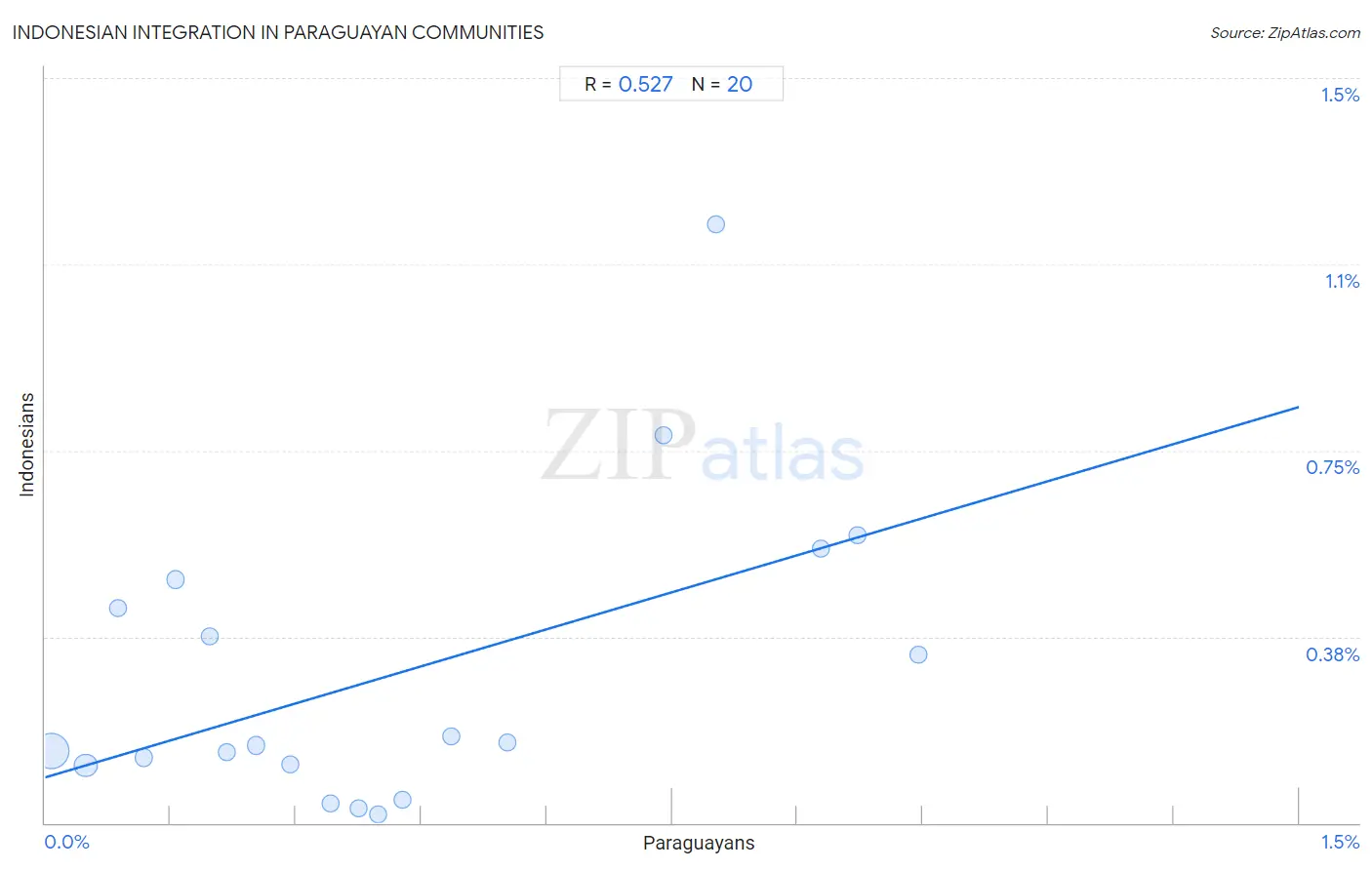
Paraguayan vs Indonesian Income
When considering income, the most significant differences between Paraguayan and Indonesian communities in the United States are seen in per capita income ($50,385 compared to $37,300, a difference of 35.1%), householder income ages 25 - 44 years ($106,615 compared to $79,543, a difference of 34.0%), and median household income ($95,737 compared to $72,856, a difference of 31.4%). Conversely, both communities are more comparable in terms of wage/income gap (25.8% compared to 22.7%, a difference of 13.7%), householder income over 65 years ($64,443 compared to $54,176, a difference of 19.0%), and median female earnings ($43,173 compared to $36,140, a difference of 19.5%).

| Income Metric | Paraguayan | Indonesian |
| Per Capita Income | Exceptional $50,385 | Tragic $37,300 |
| Median Family Income | Exceptional $114,016 | Tragic $88,301 |
| Median Household Income | Exceptional $95,737 | Tragic $72,856 |
| Median Earnings | Exceptional $51,068 | Tragic $41,701 |
| Median Male Earnings | Exceptional $59,975 | Tragic $47,503 |
| Median Female Earnings | Exceptional $43,173 | Tragic $36,140 |
| Householder Age | Under 25 years | Exceptional $55,614 | Tragic $45,566 |
| Householder Age | 25 - 44 years | Exceptional $106,615 | Tragic $79,543 |
| Householder Age | 45 - 64 years | Exceptional $109,447 | Tragic $84,890 |
| Householder Age | Over 65 years | Exceptional $64,443 | Tragic $54,176 |
| Wage/Income Gap | Average 25.8% | Exceptional 22.7% |
Paraguayan vs Indonesian Poverty
When considering poverty, the most significant differences between Paraguayan and Indonesian communities in the United States are seen in child poverty under the age of 5 (15.0% compared to 22.3%, a difference of 48.6%), child poverty under the age of 16 (14.7% compared to 21.0%, a difference of 42.6%), and child poverty among girls under 16 (15.0% compared to 21.3%, a difference of 41.8%). Conversely, both communities are more comparable in terms of seniors poverty over the age of 65 (11.4% compared to 11.5%, a difference of 0.21%), seniors poverty over the age of 75 (12.7% compared to 12.1%, a difference of 5.3%), and single father poverty (15.2% compared to 17.4%, a difference of 14.4%).
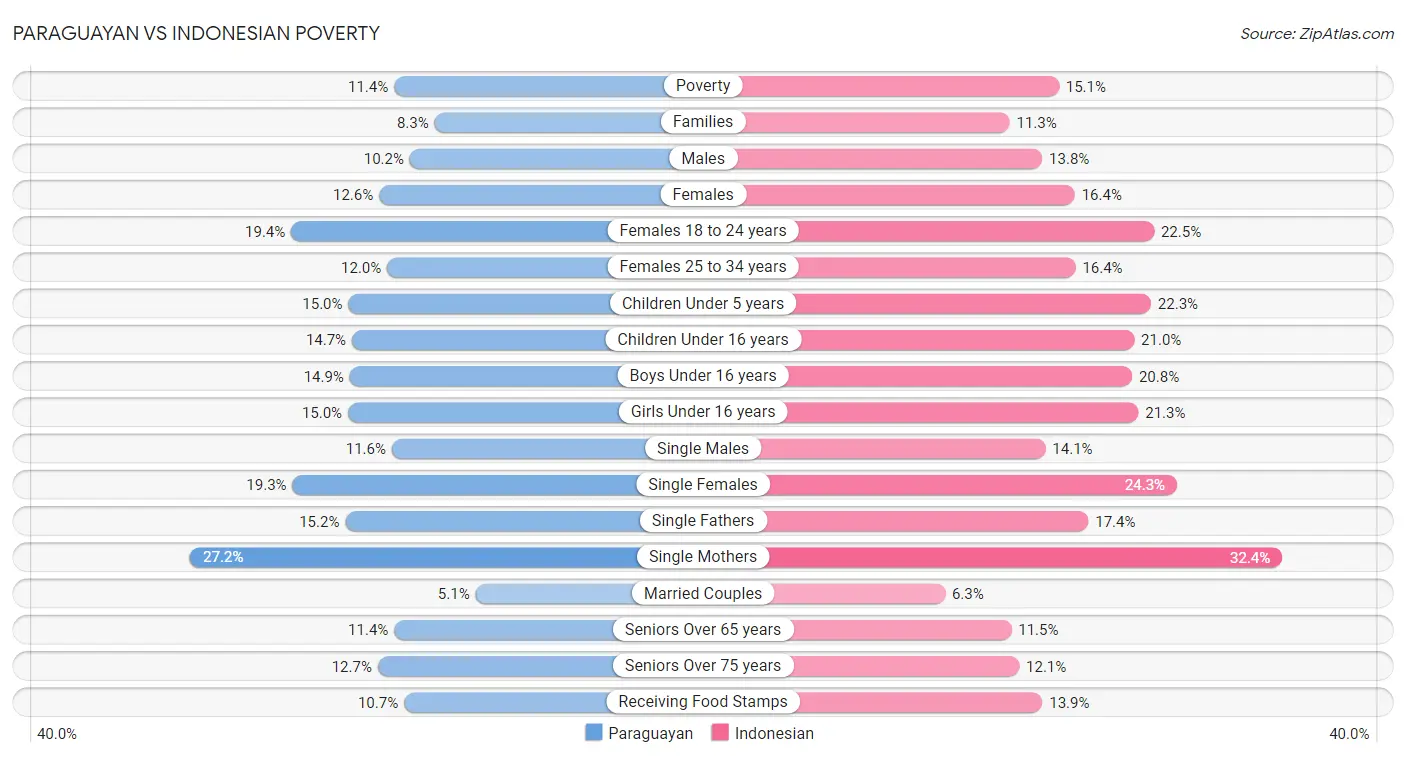
| Poverty Metric | Paraguayan | Indonesian |
| Poverty | Exceptional 11.4% | Tragic 15.1% |
| Families | Exceptional 8.3% | Tragic 11.3% |
| Males | Exceptional 10.2% | Tragic 13.8% |
| Females | Exceptional 12.6% | Tragic 16.4% |
| Females 18 to 24 years | Exceptional 19.4% | Tragic 22.5% |
| Females 25 to 34 years | Exceptional 12.0% | Tragic 16.4% |
| Children Under 5 years | Exceptional 15.0% | Tragic 22.3% |
| Children Under 16 years | Exceptional 14.7% | Tragic 21.0% |
| Boys Under 16 years | Exceptional 14.9% | Tragic 20.8% |
| Girls Under 16 years | Exceptional 15.0% | Tragic 21.3% |
| Single Males | Exceptional 11.6% | Tragic 14.1% |
| Single Females | Exceptional 19.3% | Tragic 24.3% |
| Single Fathers | Exceptional 15.2% | Tragic 17.4% |
| Single Mothers | Exceptional 27.2% | Tragic 32.4% |
| Married Couples | Good 5.1% | Tragic 6.3% |
| Seniors Over 65 years | Poor 11.4% | Poor 11.5% |
| Seniors Over 75 years | Poor 12.7% | Good 12.1% |
| Receiving Food Stamps | Exceptional 10.7% | Tragic 13.9% |
Paraguayan vs Indonesian Unemployment
When considering unemployment, the most significant differences between Paraguayan and Indonesian communities in the United States are seen in unemployment among women with children ages 6 to 17 years (10.2% compared to 7.4%, a difference of 38.0%), unemployment among ages 16 to 19 years (19.4% compared to 15.5%, a difference of 24.8%), and unemployment among ages 65 to 74 years (5.6% compared to 4.7%, a difference of 18.8%). Conversely, both communities are more comparable in terms of female unemployment (5.1% compared to 5.0%, a difference of 0.55%), unemployment among ages 30 to 34 years (5.1% compared to 5.2%, a difference of 0.61%), and unemployment among ages 45 to 54 years (4.3% compared to 4.4%, a difference of 1.5%).
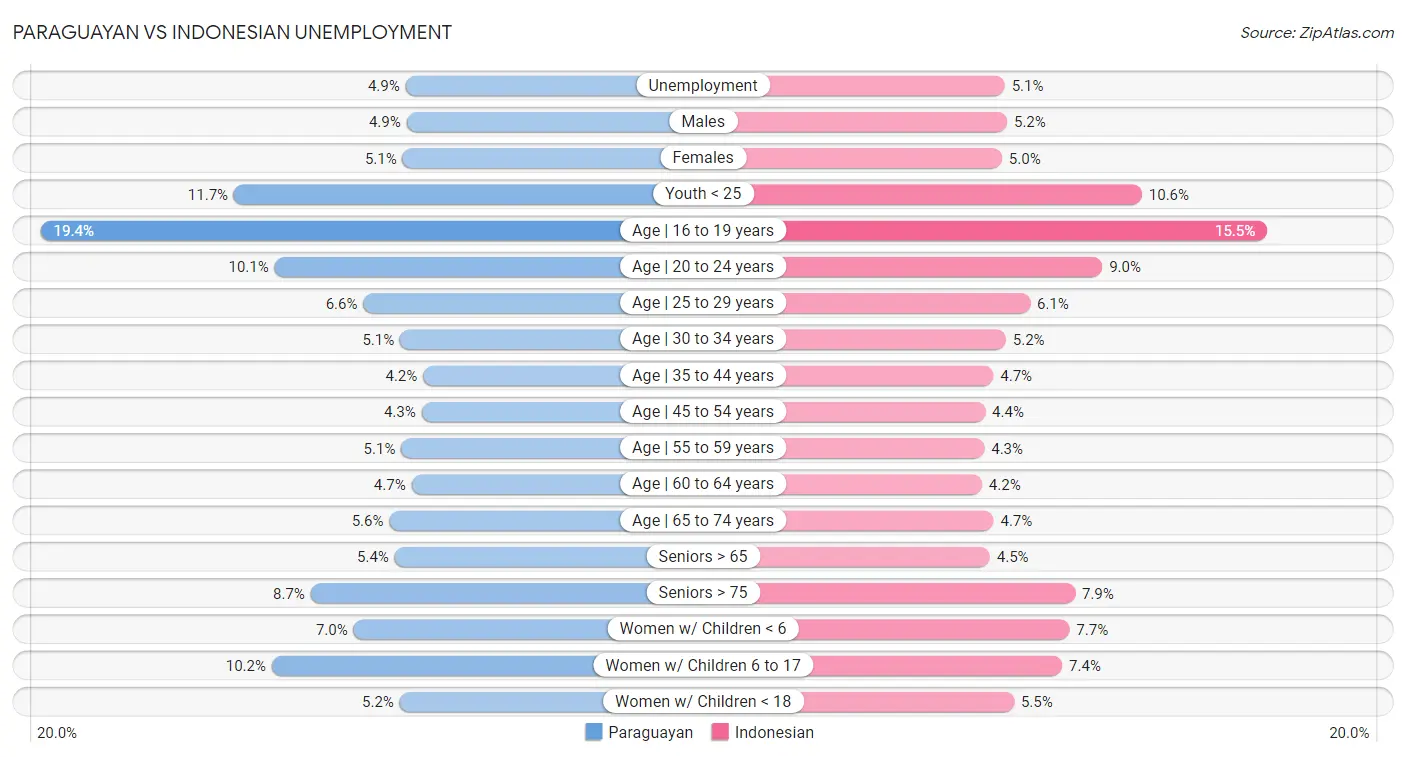
| Unemployment Metric | Paraguayan | Indonesian |
| Unemployment | Exceptional 4.9% | Excellent 5.1% |
| Males | Exceptional 4.9% | Good 5.2% |
| Females | Exceptional 5.1% | Exceptional 5.0% |
| Youth < 25 | Fair 11.7% | Exceptional 10.6% |
| Age | 16 to 19 years | Tragic 19.4% | Exceptional 15.5% |
| Age | 20 to 24 years | Excellent 10.1% | Exceptional 9.0% |
| Age | 25 to 29 years | Good 6.6% | Exceptional 6.1% |
| Age | 30 to 34 years | Exceptional 5.1% | Exceptional 5.2% |
| Age | 35 to 44 years | Exceptional 4.2% | Average 4.7% |
| Age | 45 to 54 years | Exceptional 4.3% | Exceptional 4.4% |
| Age | 55 to 59 years | Tragic 5.1% | Exceptional 4.3% |
| Age | 60 to 64 years | Exceptional 4.7% | Exceptional 4.2% |
| Age | 65 to 74 years | Tragic 5.6% | Exceptional 4.7% |
| Seniors > 65 | Tragic 5.4% | Exceptional 4.5% |
| Seniors > 75 | Good 8.7% | Exceptional 7.9% |
| Women w/ Children < 6 | Exceptional 7.0% | Average 7.7% |
| Women w/ Children 6 to 17 | Tragic 10.2% | Exceptional 7.4% |
| Women w/ Children < 18 | Exceptional 5.2% | Fair 5.5% |
Paraguayan vs Indonesian Labor Participation
When considering labor participation, the most significant differences between Paraguayan and Indonesian communities in the United States are seen in in labor force | age 16-19 (33.8% compared to 40.7%, a difference of 20.3%), in labor force | age 20-24 (73.7% compared to 77.2%, a difference of 4.7%), and in labor force | age 45-54 (83.5% compared to 81.5%, a difference of 2.5%). Conversely, both communities are more comparable in terms of in labor force | age > 16 (66.5% compared to 66.3%, a difference of 0.29%), in labor force | age 25-29 (85.9% compared to 84.7%, a difference of 1.4%), and in labor force | age 20-64 (80.6% compared to 79.4%, a difference of 1.5%).

| Labor Participation Metric | Paraguayan | Indonesian |
| In Labor Force | Age > 16 | Exceptional 66.5% | Exceptional 66.3% |
| In Labor Force | Age 20-64 | Exceptional 80.6% | Fair 79.4% |
| In Labor Force | Age 16-19 | Tragic 33.8% | Exceptional 40.7% |
| In Labor Force | Age 20-24 | Tragic 73.7% | Exceptional 77.2% |
| In Labor Force | Age 25-29 | Exceptional 85.9% | Average 84.7% |
| In Labor Force | Age 30-34 | Exceptional 85.8% | Tragic 84.3% |
| In Labor Force | Age 35-44 | Exceptional 85.4% | Tragic 83.7% |
| In Labor Force | Age 45-54 | Exceptional 83.5% | Tragic 81.5% |
Paraguayan vs Indonesian Family Structure
When considering family structure, the most significant differences between Paraguayan and Indonesian communities in the United States are seen in single mother households (5.8% compared to 7.5%, a difference of 29.7%), single father households (2.1% compared to 2.6%, a difference of 25.0%), and births to unmarried women (29.7% compared to 35.0%, a difference of 17.9%). Conversely, both communities are more comparable in terms of average family size (3.20 compared to 3.28, a difference of 2.2%), family households with children (27.1% compared to 28.1%, a difference of 3.7%), and family households (64.1% compared to 61.5%, a difference of 4.2%).

| Family Structure Metric | Paraguayan | Indonesian |
| Family Households | Fair 64.1% | Tragic 61.5% |
| Family Households with Children | Tragic 27.1% | Exceptional 28.1% |
| Married-couple Households | Good 47.0% | Tragic 42.0% |
| Average Family Size | Poor 3.20 | Exceptional 3.28 |
| Single Father Households | Exceptional 2.1% | Tragic 2.6% |
| Single Mother Households | Exceptional 5.8% | Tragic 7.5% |
| Currently Married | Good 47.2% | Tragic 43.5% |
| Divorced or Separated | Exceptional 11.5% | Tragic 12.6% |
| Births to Unmarried Women | Exceptional 29.7% | Tragic 35.0% |
Paraguayan vs Indonesian Vehicle Availability
When considering vehicle availability, the most significant differences between Paraguayan and Indonesian communities in the United States are seen in no vehicles in household (14.4% compared to 10.3%, a difference of 39.2%), 4 or more vehicles in household (4.9% compared to 6.0%, a difference of 20.6%), and 3 or more vehicles in household (16.6% compared to 18.3%, a difference of 10.4%). Conversely, both communities are more comparable in terms of 1 or more vehicles in household (85.7% compared to 89.7%, a difference of 4.7%), 2 or more vehicles in household (50.3% compared to 53.4%, a difference of 6.0%), and 3 or more vehicles in household (16.6% compared to 18.3%, a difference of 10.4%).

| Vehicle Availability Metric | Paraguayan | Indonesian |
| No Vehicles Available | Tragic 14.4% | Average 10.3% |
| 1+ Vehicles Available | Tragic 85.7% | Average 89.7% |
| 2+ Vehicles Available | Tragic 50.3% | Tragic 53.4% |
| 3+ Vehicles Available | Tragic 16.6% | Tragic 18.3% |
| 4+ Vehicles Available | Tragic 4.9% | Tragic 6.0% |
Paraguayan vs Indonesian Education Level
When considering education level, the most significant differences between Paraguayan and Indonesian communities in the United States are seen in professional degree (5.9% compared to 3.7%, a difference of 59.7%), no schooling completed (2.2% compared to 3.2%, a difference of 49.1%), and master's degree (18.8% compared to 12.6%, a difference of 48.8%). Conversely, both communities are more comparable in terms of 2nd grade (97.8% compared to 96.7%, a difference of 1.1%), nursery school (97.9% compared to 96.8%, a difference of 1.1%), and kindergarten (97.9% compared to 96.8%, a difference of 1.1%).
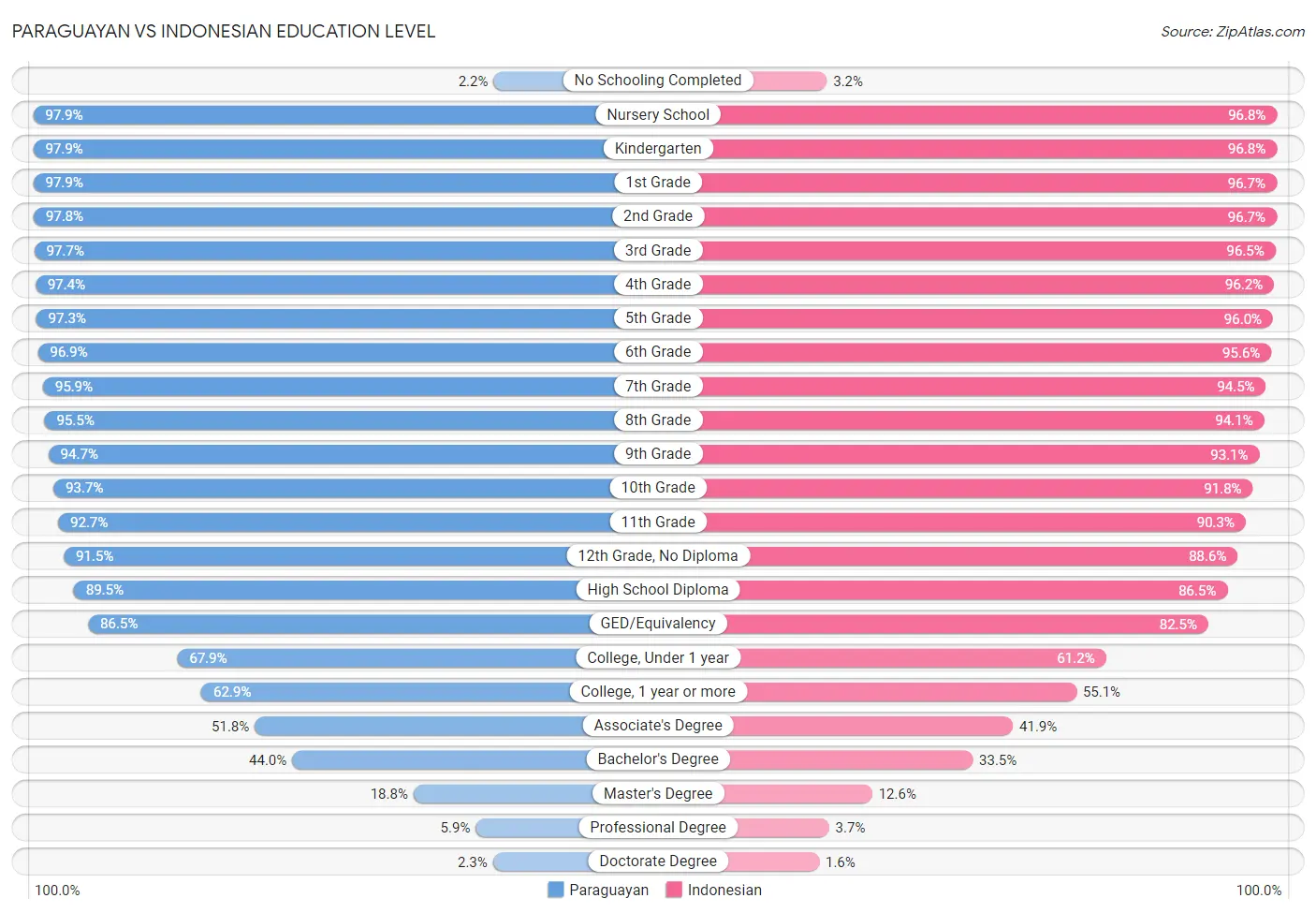
| Education Level Metric | Paraguayan | Indonesian |
| No Schooling Completed | Fair 2.2% | Tragic 3.2% |
| Nursery School | Fair 97.9% | Tragic 96.8% |
| Kindergarten | Fair 97.9% | Tragic 96.8% |
| 1st Grade | Fair 97.9% | Tragic 96.7% |
| 2nd Grade | Fair 97.8% | Tragic 96.7% |
| 3rd Grade | Fair 97.7% | Tragic 96.5% |
| 4th Grade | Fair 97.4% | Tragic 96.2% |
| 5th Grade | Fair 97.3% | Tragic 96.0% |
| 6th Grade | Fair 96.9% | Tragic 95.6% |
| 7th Grade | Fair 95.9% | Tragic 94.5% |
| 8th Grade | Fair 95.5% | Tragic 94.1% |
| 9th Grade | Fair 94.7% | Tragic 93.1% |
| 10th Grade | Average 93.7% | Tragic 91.8% |
| 11th Grade | Good 92.7% | Tragic 90.3% |
| 12th Grade, No Diploma | Good 91.5% | Tragic 88.6% |
| High School Diploma | Good 89.5% | Tragic 86.5% |
| GED/Equivalency | Excellent 86.5% | Tragic 82.5% |
| College, Under 1 year | Exceptional 67.9% | Tragic 61.2% |
| College, 1 year or more | Exceptional 62.9% | Tragic 55.1% |
| Associate's Degree | Exceptional 51.8% | Tragic 41.9% |
| Bachelor's Degree | Exceptional 44.0% | Tragic 33.5% |
| Master's Degree | Exceptional 18.8% | Tragic 12.6% |
| Professional Degree | Exceptional 5.9% | Tragic 3.7% |
| Doctorate Degree | Exceptional 2.3% | Tragic 1.6% |
Paraguayan vs Indonesian Disability
When considering disability, the most significant differences between Paraguayan and Indonesian communities in the United States are seen in disability age under 5 (2.0% compared to 1.2%, a difference of 71.5%), disability age 35 to 64 (9.8% compared to 13.2%, a difference of 34.6%), and disability age 18 to 34 (5.9% compared to 7.2%, a difference of 21.7%). Conversely, both communities are more comparable in terms of disability age over 75 (45.0% compared to 48.2%, a difference of 7.1%), self-care disability (2.3% compared to 2.5%, a difference of 9.7%), and vision disability (2.0% compared to 2.2%, a difference of 10.6%).
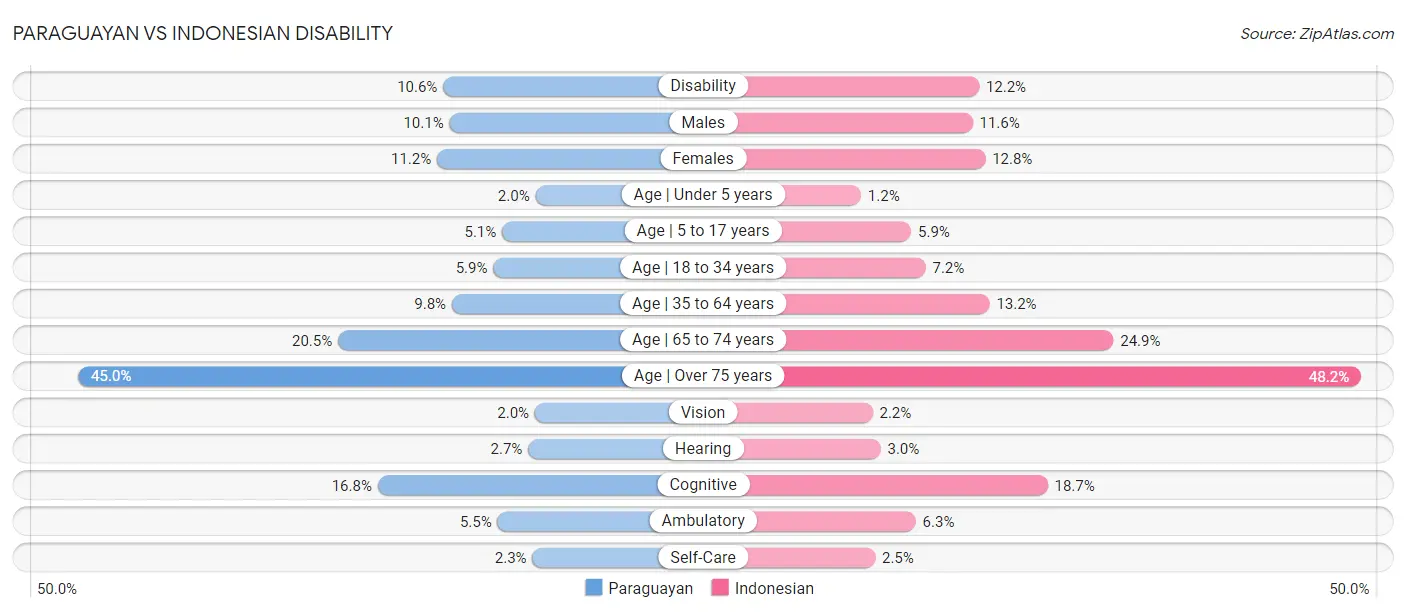
| Disability Metric | Paraguayan | Indonesian |
| Disability | Exceptional 10.6% | Tragic 12.2% |
| Males | Exceptional 10.1% | Tragic 11.6% |
| Females | Exceptional 11.2% | Tragic 12.8% |
| Age | Under 5 years | Tragic 2.0% | Exceptional 1.2% |
| Age | 5 to 17 years | Exceptional 5.1% | Tragic 5.9% |
| Age | 18 to 34 years | Exceptional 5.9% | Tragic 7.2% |
| Age | 35 to 64 years | Exceptional 9.8% | Tragic 13.2% |
| Age | 65 to 74 years | Exceptional 20.5% | Tragic 24.9% |
| Age | Over 75 years | Exceptional 45.0% | Tragic 48.2% |
| Vision | Exceptional 2.0% | Tragic 2.2% |
| Hearing | Exceptional 2.7% | Average 3.0% |
| Cognitive | Exceptional 16.8% | Tragic 18.7% |
| Ambulatory | Exceptional 5.5% | Tragic 6.3% |
| Self-Care | Exceptional 2.3% | Average 2.5% |